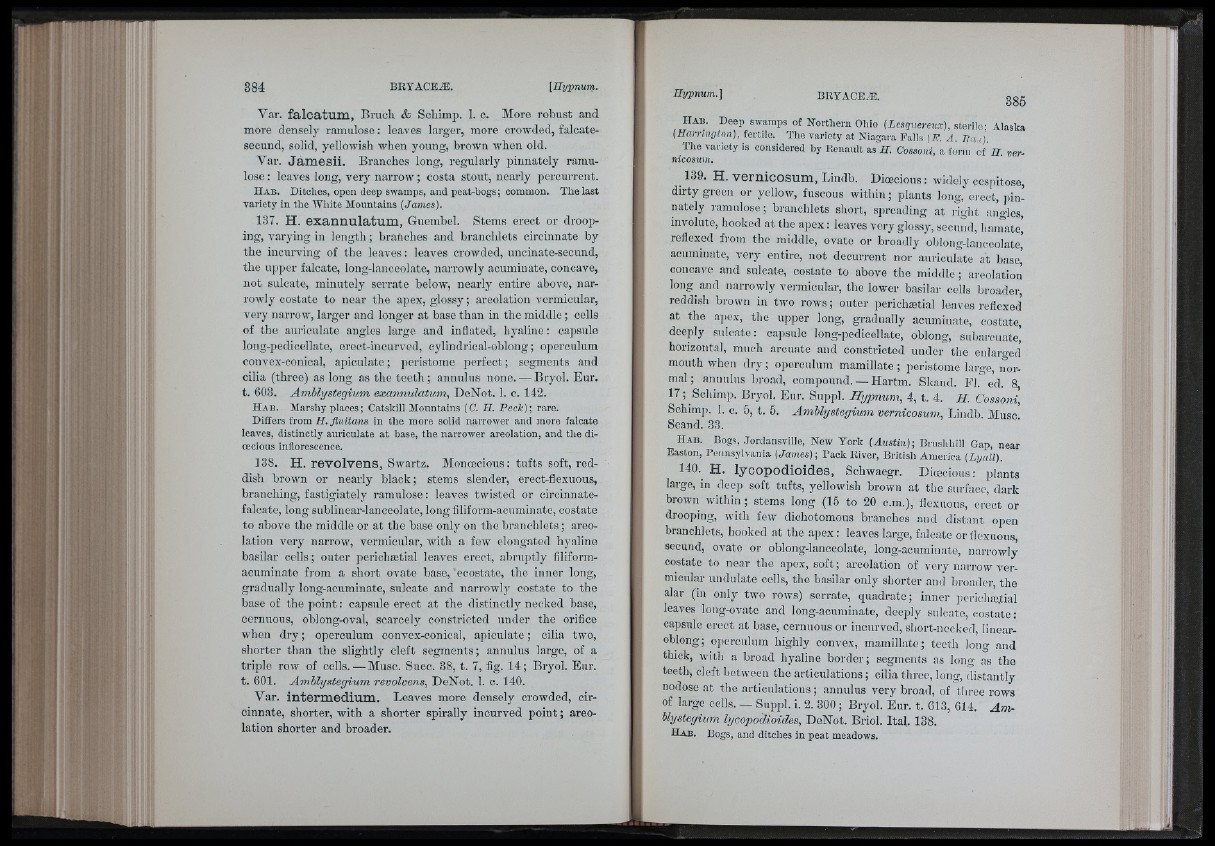
! • : i i
I ‘
! , ■ I
f -Mí ,
í Y f i I
i Mili
MU- ' y tete
■ 'i ' L ' ^ •
H M;:
i.ii^telte
ií:
t , . \
'" í;í:'
p ' l ' C ;!•••
r ;i:
Var. fa lc a tum , Bracli & Schimp. 1. c. More robust and
more densely ramulose : leaves larger, more crowded, falcate-
secund, solid, yellowish when young, brown when old.
Var. J am e sii. Branches long, regularly pinnately ramulose
: leaves long, very narrow ; costa stout, nearly percurrent.
H a b . Ditches, open deep swamps, and peat-bogs; common. The last
variety in the AViiite Mountains (James).
137. H. e x a n n u la tum , Guembel. Stems erect or drooping,
varying in length ; branches and branchlets cireinnate by
the incurving of tho leaves : leaves crowded, uncinate-seound,
the upper falcate, long-lanceolate, narrowly acuminate, concave,
not sulcate, minutely serrate below, nearly entire above, narrowly
costate to near the apex, glossy ; areolation vermicular,
very nari'ow, larger and longer at base than in the middle ; cells
of the auricnlate angles large and inflated, liy.aline: capsule
long-pedicellate, erect-incurved, cylindrical-oblong ; operculum
convex-conical, apiculate ; peristome perfect ; segments and
cilia (three) as long as the teeth; annulus none. — Bryol. Eur.
t. 603. Amblystegium exannulatum, DeNot. 1. c. 142.
H a b . Marshy places; Catskill Mountains (C. H. Peck); rare.
Differs from H. fluitans in the more solid narrower and more falcate
leaves, distinctly atiriculate at base, the narrower areolation, and the dioecious
inflorescence.
188. H. rev o lv en s, Swartz. Monoecious: tufts soft, reddish
brown or nearly black; stems slender, erect-flexuous,
branching, fastigiately ramulose : leaves twisted or circinnate-
falcate, long sublinear-lauceolate, long filiform-acuminate, oostate
to above the middle or at the base only on the branchlets ; areolation
very narrow, vermicular, with a few elongated hyaline
basilar cells; outer perichætial leaves erect, abruptly filiform-
acuminate from a short ovate base, ecostate, the inner long,
gradually long-acnminate, sulcate and narrowly costate to the
base of the point : capsule erect at the distinctly necked base,
cernuous, oblong-oval, scarcely constricted under the orifice
when dry ; operculum convex-conical, apiculate ; cilia tivo,
shorter tlian the slightly cleft segments ; annulus large, of a
triple row of cells.—Muse. Suec. 38, t. 7, fig. 14; Bryol. Eur.
t. 601. Amblystegium revolvens, DeNot. 1. c. 140.
Var. in term ed ium . Leaves more densely crowded, cir-
cinnate, shorter, with a shorter spirally incurved point; areolation
shorter and broader.
H a b . Deep swamps of Northern Ohio (Lesquereux), sterile; Alaska
{Harruvjton), fertile. The variety at Niagara Falls [E, A. Bau).
Tlie variety is considered by Itenault as IL Cossoni, a form of II. ver-
nicosum.
139. H. v e rn ico sum , Lindb. Dioeoious : widely ces]iitose,
dirty green or yellow, fuscous within; plants long, erect, pinnately
ramulose ; branchlets short, spreading at right angles,
involute, hooked at the apex : leaves very glossy, secund, hamate!
reflexed from the middle, ovate or broadly obloiig-lanceolate,
acuminate, very entire, not decurrent nor auricnlate at base!
concave and sulcate, costate to above tho middle; areolation
long^ and narrowly vermicular, the lower basilar colls broader,
reddish brown in two rows ; outer perichætial leaves reflexed
at the ajiex, the upper long, gradually acuminate, costate,
deeply sulcate: capsule long-pedicellate, oblong, subarcuate!
horizontal, much arcuate and constricted under the enlarged
mouth when dry ; operculum mamillate ; peristome large, normal
; anmilus broad, compound. — Hartm. Skand. FI.“ ed. 8
17; Schimp. Bryol. Eur. Suppl. Ilypnum, 4, t. 4. H. Cossoni,
Schimp. I. c. 5, t. 5. Amblystegium vernicosum, Lindb. Muse.
Scand. 33.
Ha b . Bogs, .Torclansville, New York (Austin); Brushhill Gap, near
Easton, Pennsylvania (James) ; Pack River, British America (Lyall).
140. H. lycopodioides, Schwaegr. Dioecious: plants
large, in deep soft tufts, yellowish brown at the surface, dark
brown within ; stems long (15 to 20 c.m.), flexuous, erect or
drooping, with few dichotomous branches aud distant open
branchlets, hooked at the apex : leaves large, falcate or flexuous,
secund, ovate or ohlong-lanceolate, long-acuminate, narrowly
costate to near the apex, soft; areolation of vei-y nari-ow vermicular
nndulate cells, the basilar only sliorter and broader, the
alar (in only two rows) serr.ate, quadrate; inner perieliæ.tial
leaves long-ovate and long-aoimiiiiate, deeply sulcate, costate :
capsnle erect at base, cernuous or incurved, short-iiccked, linear-
oblong; operculum highly convex, mamillate; teeth long and
thick, witli a broad hyaline border; segments as long as the
teeth, cleft between the articulations ; cilia three, long, distantly
nodose at the articulations; .annulus very broad, of three rows
of large cells. — Suppl. i. 2. 300 ; Bryol. Eur. t. 613, 614. Aiii-
blystegiwn lycopodioides, DeNot. Briol. Ital. 138.
Hab. Bogs, and ditches in peat meadows.